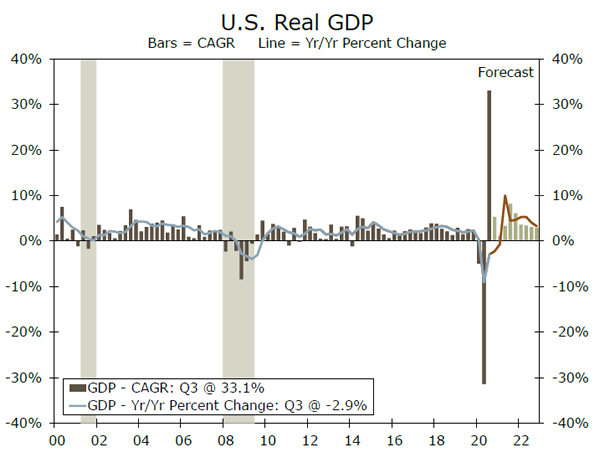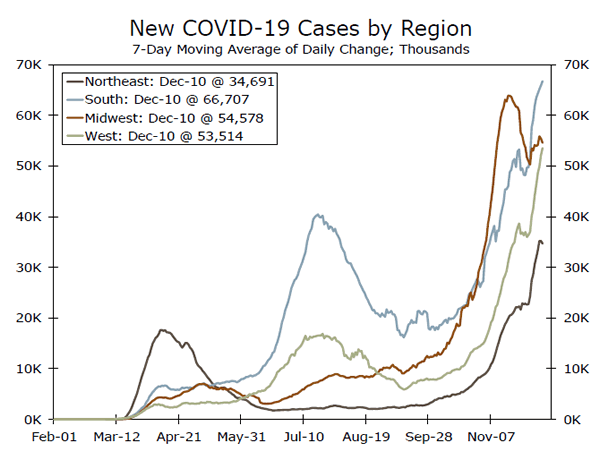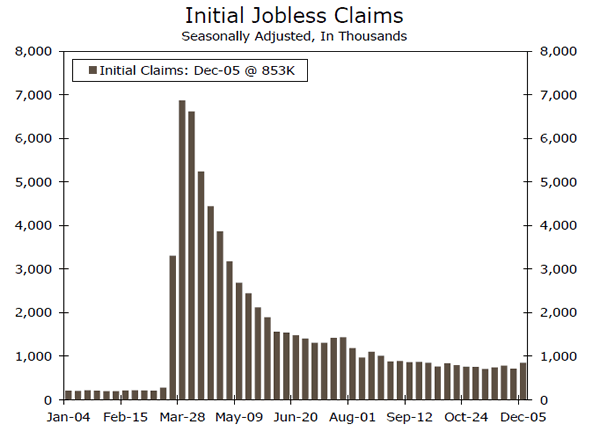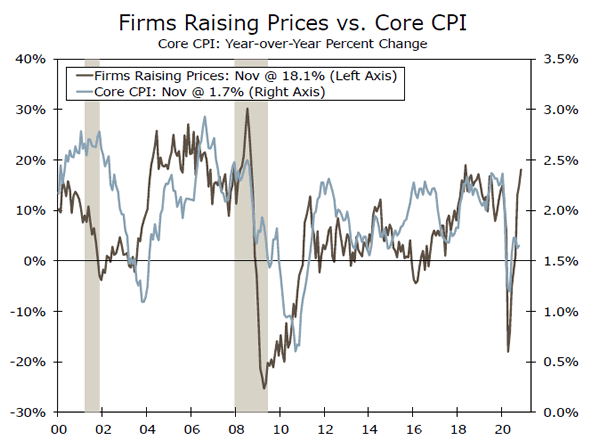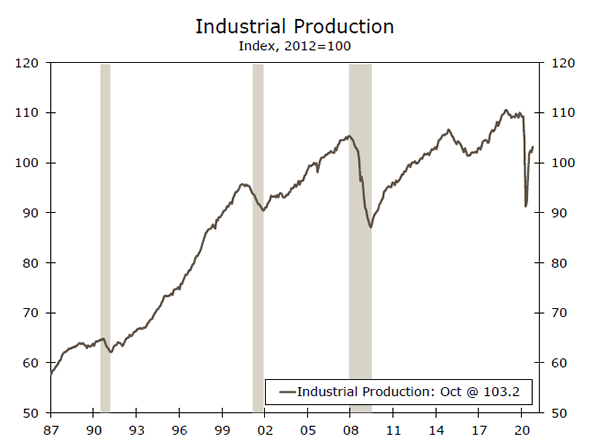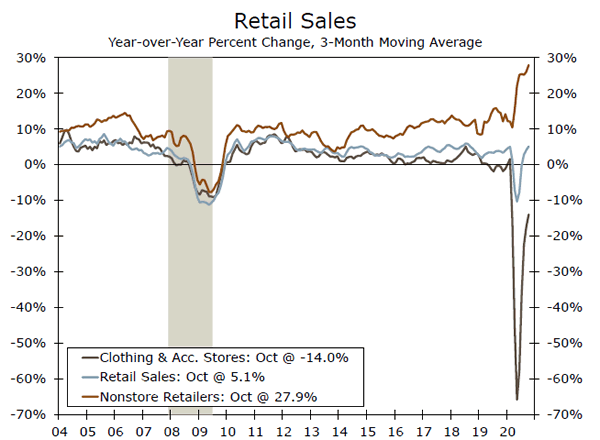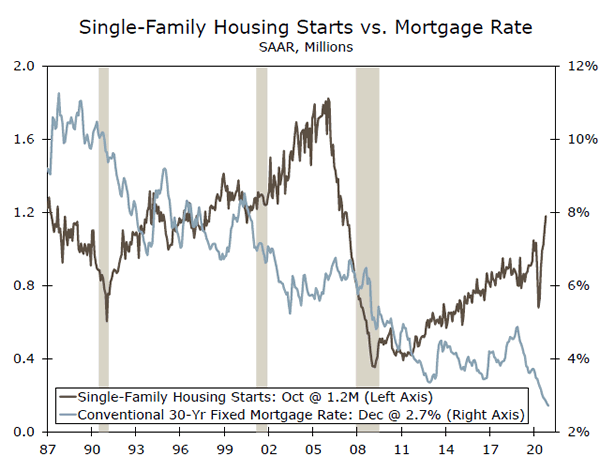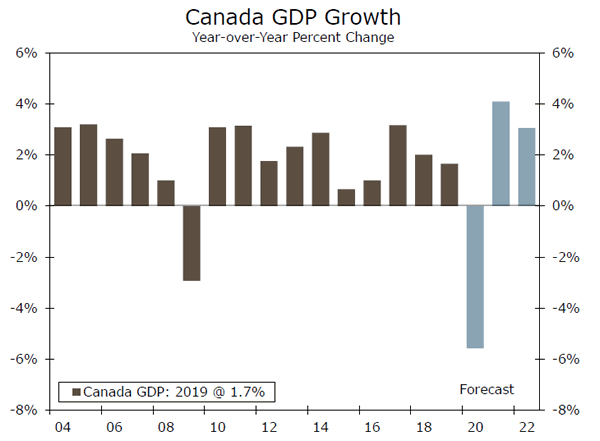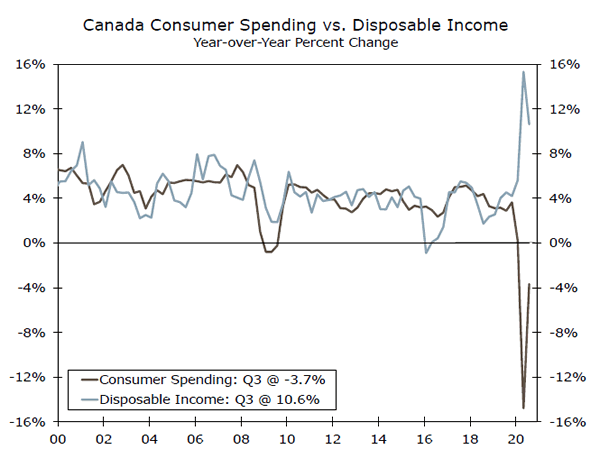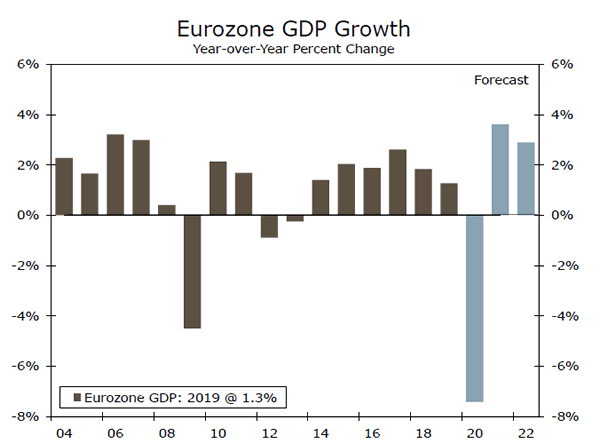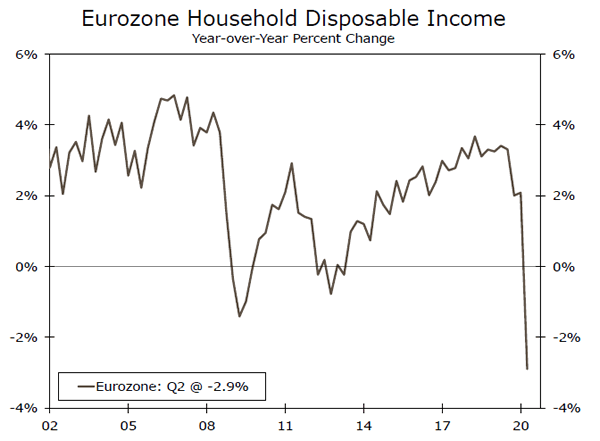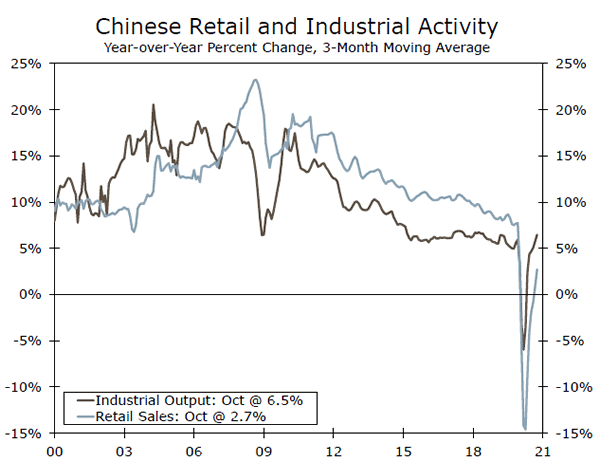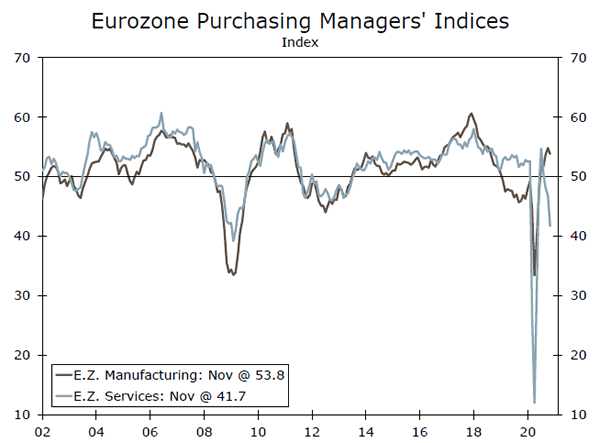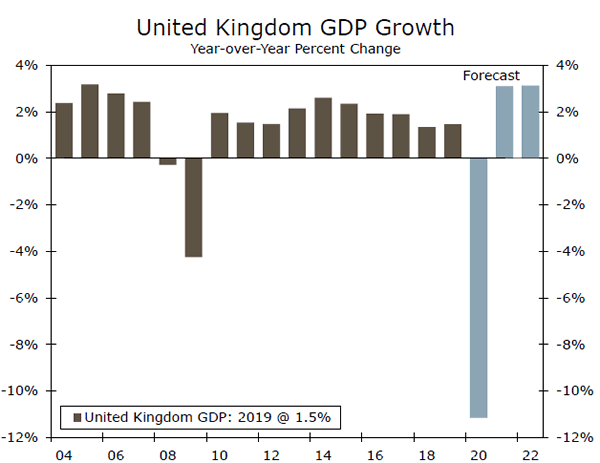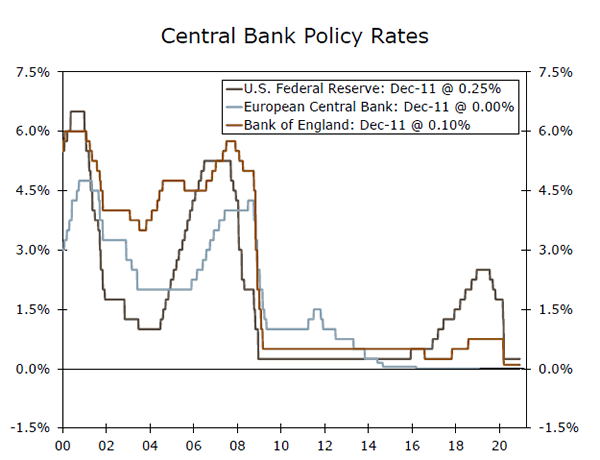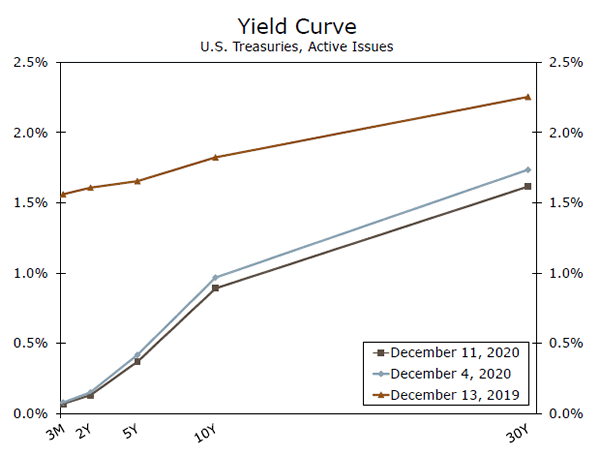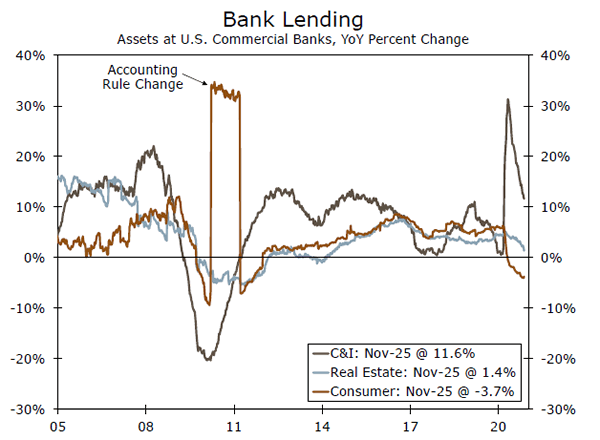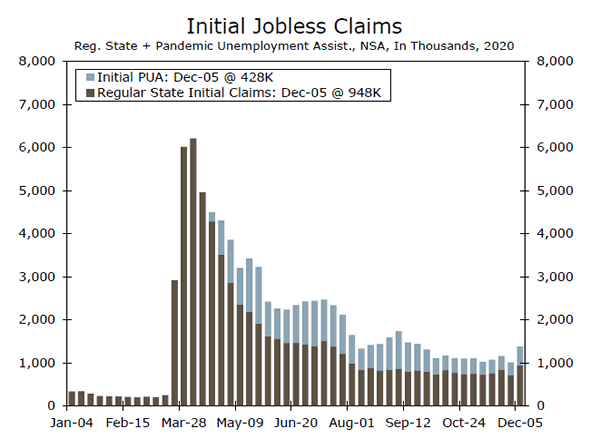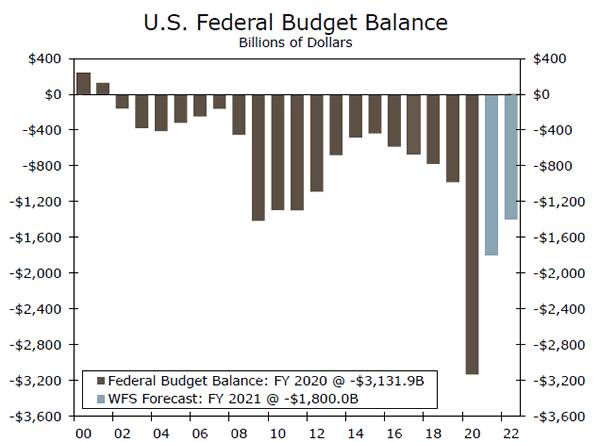U.S. Review
Winter Is Here
- Emergency authorization of the Pfizer-BioNTech COVID vaccine appears imminent, but the virus is running rampant across the United States today, pointing to a grim winter.
- Despite continued negotiations, additional COVID-relief remains elusive (see topic of the week on page 7) while initial claims for unemployment insurance have increased in three out of the past five weeks.
- Consumer prices rose 0.2% and the underlying trend in inflation looks set to firm over the course of next year.
- We released our 2021 Annual Economic Outlook this week.
Winter Is Here
Recent data continue to suggest a resilient economy, but the recovery has undeniably shifted into a lower gear amid rising virus cases. Medical advisers to the FDA recommended approval of the Pfizer-BioNTech COVID vaccine this week, clearing the way for FDA emergency authorization. Vaccine approval is undeniably a positive end to a year shaken by the pandemic, but the virus is running rampant across the United States today. The reality is that vaccines won’t be available to the general public for months, and further fiscal support would be instrumental to ensure a continued economic recovery in the event virus cases lead to a renewed pullback in activity.
Local governments have re-instated stay-at-home guidelines and mobility restrictions like curfews to try and curb the spread of the virus. Even in the absence of government-mandated restrictions however, activity may subside. We continue to expect a decent holiday sales season for retailers, but households may rein in spending in the new year as recent case counts point to a grim winter. Consumer sentiment, however, has held up in early December rising to the second-highest level since March. Sentiment was likely boosted by vaccine hopes and the glimpse of a possible end to the pandemic, with both current conditions and expectations improving.
Still, many households continue to struggle and the absence of an additional fiscal relief package would leave millions of Americans without unemployment benefits at the start of the new year. Further, an additional 853K workers, up 137K from the week prior and representing the highest weekly increase since March, filed an initial claim for unemployment insurance last week. Although job openings have improved, they remain about 5% lower than February. It’s not just decreased demand for labor that continues to constrain the jobs recovery, but also supply. The labor force has fallen by a whopping 4.1M workers since February as childcare and health concerns have stopped millions from looking for jobs.
Optimism of small business owners has also recently wavered as the Small Business Optimism Index subsiding in November. With earnings continuously under pressure and operating costs rising, the share of businesses expecting to raise prices continues to trend higher and foreshadowing inflation. Indeed, consumer prices increased 0.2% last month as initial pandemic-effects continued to unwind. The 12-month change in inflation should jump in the second quarter due to favorable base effects after the pandemic led to historic price declines this year. While the underlying inflation trend should firm over the course of the year, the roughly 2 ½ percent rate of core CPI in Q2-2021 is unlikely to last, and we expect will be dubbed “transitory” by the FOMC.
Is It 2021 Yet?
As we look to next year, we echo many of these themes in our 2021 Annual Economic Outlook. Our latest projections have the U.S. economy contracting 3.5% this year before increasing 4.5% in 2021 and again in 2022. Although there remains a great deal of uncertainty in the outlook, as the calendar flips to 2021, we increasingly see light at the end of the tunnel. Although it may still be a long trek back to a pre-pandemic economy, it appears we are well on our way.
U.S. Outlook
Industrial Production • Tuesday
In prior cycles, the rebound in manufacturing has taken longer than the recovery in broader economic activity. But in this cycle we have already seen industrial production retrace more than half of its losses from the cratering in output from the shutdowns in the spring.
A few factors are at play here. The first is that goods-spending has been the primary driver of the consumer rebound, even as spending on services has been sharply curtailed. The other is that the manufacturing sector is better suited for the implementation of social-distancing, mask-wearing and other safety protocols.
But a full recovery depends upon a sustained upturn in global growth and that, in turn, will depend upon vaccine distribution. We expect another solid monthly increase when industrial production for November is published on Tuesday.
Previous: 1.1% Wells Fargo: 0.4%
Consensus: 0.3% (Month-over-Month)
Retail Sales • Wednesday
The level of retail sales is higher now than it was before the pandemic, but that varies quite a bit when you look at spending by store type. Gas stations are seeing fewer fill-ups as many former office workers have eliminated their commutes. The work from home (WFH) trend has also diminished spending at clothing stores, although that is starting to rebound. The big winner has been e-commerce (non-store retailers in the chart to the left).
We will be on pins and needles Wednesday morning waiting for the November figures to hit the wire as it will be critical for holiday sales. We are banking on a monthly decline for November—as a lot of holiday-oriented spending got pulled into October this year with Prime Day and other early savings specials with stores “season pushing” on us. A larger-than-expected decline could cast doubts for retailers in these make-or-break year-end months.
Previous: 0.3% Wells Fargo: -0.2%
Consensus: -0.2% (Month-over-Month)
Housing Starts • Thursday
Who knew that a pandemic would be so good for residential construction activity? The combination of a desire for more elbow room along with a sharp drop in mortgage rates has resulted in more single-family homes going up than at any point since the height of the housing boom in the mid-2000s.
Admittedly, multifamily starts, the bulk of which are apartments, have been unchanged since August at 351,000 units and we would not be surprised to see this segment level off near the current level. There is still an immense undersupply of all types of housing, particularly affordable rental housing which may keep multifamily construction from slowing too much.
Homebuilder confidence has never been higher than it was in November since at least the 1980s, so we expect the annualized pace of housing starts to come in at 1,516K on Thursday.
Previous: 1,530K Wells Fargo: 1,516K
Consensus: 1,530K (SAAR)
Global Review
Central Banks Reaffirm Extraordinary Stimulus
- There were a couple key central bank meetings this week, starting with the Bank of Canada (BoC). The BoC left its policy rate and quantitative easing program unchanged, while maintaining its forward guidance.
- The European Central Bank (ECB) also met this week to assess monetary policy. The ECB increased purchases under its Pandemic Emergency Purchase Program (PEPP) by €500 billion, extended the duration of those purchases through at least March 2022 and pushed the reinvestment period of maturing PEPP securities through at least the end of 2023.
Central Banks Reaffirm Extraordinary Stimulus
There were a couple key central bank meetings this week, starting with the Bank of Canada (BoC). The BoC left its policy rate and quantitative easing program unchanged while maintaining its forward guidance that the policy rate will be left near zero “until economic slack is absorbed so that the 2% inflation target is sustainably achieved.”
Canada, like most countries, has seen its economy contract in 2020 (see chart on front page). But in Canada, fiscal support has been more forthcoming than it has been in many other places, setting up the Canadian economy to bounce back strongly in 2021. Given government support measures, household income trends remain very sound. Household disposable incomes were up a stunning 15.3% year-over-year in Q2 and 10.6% in Q3 (top chart). Even with the jump in consumer spending in Q3, the household saving rate was still 14.6%, well above pre-pandemic levels.
Thus, Canadian households should have plenty of firepower to ramp up their spending once vaccines are widely distributed in the second half of 2021. Monetary policy tightening in most developed countries, including Canada, is likely a long ways off. But, if Canada can close its output gap faster than most of its peers, the BoC may eventually be one of the first central banks to start unwinding the extraordinary monetary policy stimulus that has been implemented in 2020.
The European Central Bank (ECB) also met this week to assess monetary policy. Prior to the meeting, there was an expectation for additional monetary policy easing, as ECB President Christine Lagarde telegraphed the direction of policy well ahead of the meeting. Markets were looking for ECB policymakers to move forward with increases to its pandemic asset purchase program, extend the duration of those purchases, as well as make adjustments to its targeted longer-term refinancing operations.
The ECB broadly met these expectations. In summary, the ECB increased purchases under its Pandemic Emergency Purchase Program (PEPP) by €500 billion, taking the size of the PEPP to €1.85 trillion. The central bank also extended the duration of those purchases through at least March 2022 and pushed the reinvestment period of maturing PEPP securities through at least the end of 2023. In addition, terms for the third series of TLTRO operations were recalibrated so that favorable lending terms would be extended an additional 12 months to June 2022, while three additional operations will now be conducted in the second half of 2021.
The ECB largely delivered on expectations for additional monetary policy relief. But while any port in a storm will be welcome for the ailing Eurozone economy, we doubt we will make any major revisions to our forecasts for Eurozone GDP growth and inflation based off of this week’s policy changes (middle chart). Eurozone household disposable income fell 2.9% year-over-year in Q2, and was likely flat in Q3 (bottom chart). In part because there is less dry powder on the household side, our forecast for 2021 real GDP growth in the Eurozone is more muted than it is in Canada.
Global Outlook
China Retail Sales • Monday
Next week Chinese officials will report data on November retail sales, industrial production and fixed investment. China continues to be a leader in the containment of COVID as new confirmed cases are minimal. In addition to virus containment, aggressive monetary and fiscal stimulus have been implemented and critical to the pickup in economic activity. At the sector level, however, the recovery has been more uneven. Through October, Chinese industrial production had risen 1.8% year-to-date, while retail sales were still down 5.9%.
China’s apparent success in controlling the spread of COVID, as well as its robust factory sector, suggests it is well-placed to lead the economic rebound. Indeed, China is the only major economy for which we forecast positive GDP growth for full-year 2020 (+2.2%), while in 2021 we expect China’s GDP growth to surge to 9.6% before falling back to less than 6% in 2022.
Previous: -5.9%
Consensus: -4.9% (Year-to-Date, Year-over-Year)
Eurozone PMIs • Wednesday
The Eurozone PMIs for December could be a market moving data release next week. Tighter government restrictions in Europe went into place over the course of the past couple of months as COVID cases skyrocketed. The November PMI data reflected these tighter restrictions/greater spread of the virus, as the services PMI declined to 41.7, the lowest reading since May.
We believe it has become clear that the Eurozone economy will contract in Q4. The question now is just how much it will contract. We do not expect as big of a decline in output as occurred in the spring, and look for the Eurozone economy to contract about 3% quarter-over-quarter (not annualized). But, it remains unclear just how long current restrictions will remain in place. The Eurozone PMIs are fairly effective when used as inputs for forecasting quarterly GDP growth, so a surprise reading in either direction could lead forecasters to adjust their expectations for Q4 and/or Q1-2021.
Previous: 45.3
Consensus: 45.5 (Composite Index)
Bank of England Meeting • Thursday
At its previous meeting on November 5, the Bank of England (BoE) eased monetary policy further by announcing a £150B increase in its asset purchase target to £895B. Those additional bond purchases are expected to begin in January and continue until the end of 2021. The BoE kept its policy interest rate unchanged at 0.10%.
Like the Eurozone, the U.K. economy has struggled mightily with COVID outbreaks, and behavioral changes coupled with government restrictions, which have weighed heavily on the British economy. Making matters worse, Brexit uncertainty that never seems to go away is likely further restraining the pace of economic growth. We expect U.K. real GDP to contract over 11% in 2020, which if realized would be the biggest contraction among the 14 countries (counting the Eurozone as one) we forecast. Although our base case at this time is for no further easing from the BoE, we acknowledge that the risks are still tilted toward further policy action.
Previous: 0.10% Wells Fargo: 0.10%
Consensus: 0.10% (Bank Rate)
Point of View
Interest Rate Watch
Will the FOMC Do Anything Next Week?
Members of the Federal Open Market Committee (FOMC) will gather in Washington, D.C. on December 15 and 16 for their last meeting of 2020. Although there is universal agreement among observers that the committee will not make any changes to its target range for its main policy rate, which currently is 0.00% to 0.25%, there are some other steps that the FOMC could take.
Let’s start with its asset purchases. The Federal Reserve is currently buying $80 billion worth of Treasury securities and $40 billion of mortgage-backed securities every month. The rationale of these purchases has been twofold: to improve the functioning in these financial markets, which encountered bouts of illiquidity in the spring, and to “foster accommodative financial conditions” more broadly. But liquidity has returned to most financial markets, so ensuring monetary accommodation in now the main purpose of the asset purchases.
As we wrote in a recent report, we do not look for the FOMC to change the size or the composition of its asset purchases at next week’s meeting. However, the committee could potentially give more specific guidance around the time horizon for continued purchases rather than the vague “over coming months” which it has been using. In our view, any action that the FOMC takes in regard to its guidance will ensure that long-term interest rates remain at low levels for the foreseeable future.
The committee is also slated to release its quarterly Summary of Economic Projections (SEP), in which it outlines its macroeconomic forecasts and its projections for its main policy rate. In the September SEP, only one of 17 committee members thought that a rate hike would be appropriate by the end of 2022 and 13 members thought that the FOMC would be on hold through the end of 2023. We will be watching closely to see if the FOMC changes its mind about the outlook for its main policy rate.
Credit Market Insights
Revolving Credit Sinks Headline
Consumer credit missed consensus expectations in October rising a mere $7.2B. The gain was constrained by revolving credit, mostly consisting of credit card loans, which declined $5.5B and now sits 10% below where it was a year-ago, the largest year-over-year decline in history. Nonrevolving credit rose a solid $12.7B.
The marked decline in revolving credit could reflect increasingly worried consumers reducing spending or their increased reliance on personal saving they have built in recent months (rather than borrowing) to fund consumption. Consumer credit as a percent of disposable income has improved since its April low, but remains well-below pre-virus norms as demand for credit remains constrained.
Although mobility restrictions eased over the summer months, the colder weather and holiday season has brought an onslaught of new COVID cases across the nation, leading many localities to implement new social distancing restrictions. Revolving credit may remain depressed in coming months as personal spending adjusts to fit our constantly changing social distancing standards. Gift purchases will likely push back against the effect of the new lockdowns in the holiday sales season; we expect that personal consumption for Q4 of this year will come in strong at a 4.9% annualized rate. However, we forecast consumption will get off to a rocky start in Q1-2021, declining one percent (annualized) as lockdowns increase, before rising 3.7% in Q2 and skyrocketing 10.8% in Q3 as vaccinations clear the way for a resurgence in services spending.
Topic of the Week
New Relief Proposals, Old Sticking Points
Stimulus talks took center stage yet again this week, as new relief proposals rekindled the topic. Last week brought on an important first step toward a deal as House Speaker Nancy Pelosi and Senate Minority Leader Chuck Schumer backed a $908 billion bipartisan Senate plan, down considerably from Democrats’ $2 trillion pre-election proposal. Senate Republican leadership also proposed a plan last week that was similar to a $650 billion bill from in mid-September, and this week Treasury Secretary Steven Mnuchin put forth a $916 billion proposal with the backing of the White House.
For now, our latest economic forecast continues to assume no additional stimulus. As we noted in a report last week, several outstanding issues remain—most notably on state & local aid and liability reform. These issues have proved intractable for months and, despite the progress of the past two weeks, lawmakers are still struggling to thread the needle with very little time left before Congress leaves for the holidays.
Moreover, the proposal from Secretary Mnuchin raised new questions, as the $916 billion plan included $600 dollar checks to households—which were not included in the latest framework released by the bipartisan group of senators or by Senate Republican leadership—at the expense of higher unemployment benefit payments. The focus on unemployment benefits has re-entered the spotlight at a time when initial claims for unemployment recently increased the most since March.
In addition to these sticking points, the government still needs to pass a funding bill to avert a government shutdown. The House passed a one-week stop-gap funding measure on Wednesday, sending it to the Senate for final approval. This continuing resolution would fund the government through December 18, setting up yet another deadline by which lawmakers will strive to solve the COVID-relief puzzle.




